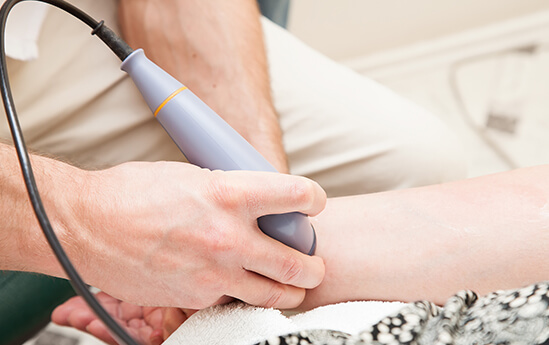Ultrasound Therapy

Ultrasound therapy is used by physical therapist to treat a range of injuries for their patients such as, muscle and tendon injuries that is causing pain and discomfort. When the typical over-the-counter pain relief medications are not effective or cannot be taken be a patient for whatever reason such as an allergy, the patient can consider other more therapeutic options like ultrasound therapy.
The basics of ultrasound therapy is using different intensities and frequencies of sound to stimulate the injured area. Kind of like a vibration type of therapy. The technique has been used since early 1940’s and has since been proven a very effective method to increase in local blood flow to the injured area which helps to reduce local swelling and chronic inflammation. According to some studies ultrasound therapy has also been known to promote the healing of a bone fracture. The more forward benefit to this treatment option is that it doesn’t involve having to take more medications and it is a more non-invasive, natural approach to healing. It’s the ideal approach for patients who are not comfortable with injections or have allergies to certain medications.
During an ultrasound therapy session, here’s what you can expect:
- It only takes about 3-5 minutes depending on the area being treated.
- You feel no pain or discomfort from the treatment itself.
- The ultrasound is applied just like how a pregnant women would receive an ultrasound around the abdomen except the round headed wand or probe would be applied to the injured area, directly onto the patient’s skin such as the knee or shoulder.
- A gel is applied to the skin first to allow the wand to move smoothly and without friction.
- During the ultrasound therapy session, the wand will be moving constantly. The sound waves that are transmitted through the skin will cause a vibration of the local tissues.
- Again, patients won’t normally feel any pain unless there is a minor break in a bone close to the surface, In this case a patient might feel a sharp pain. What happens is the sound waves could become trapped between two parts of the break which will translate to a sharp pain however, this can be result in an accurate way of diagnosing a fracture.
Some common conditions that have been treated with ultrasound therapy are:
Whiplash
An injury to the neck caused when the neck is jerked in a back-and-forth motion, following a rapid acceleration or deceleration of force. Symptoms usually appear within 24 hours of the incident and can include, headaches, neck pain, back pain, jaw pain, fatigue, dizziness, and nausea.
Degenerative Disc Disease
A condition in which the fibrous disks that work to absorb the shock between the spine’s vertebrae bones lose their moisture content as someone ages naturally, becoming more brittle and shrink in size. The discs begin to feel less sponge-like which can cause inflammation or put direct pressure on the spinal nerve. The process of disk degeneration may be accelerated by trauma from a sports injury, lifting, and other physical activities. It can occur in any part along the spine, but is most often occurs in the neck and back.
Osteoarthritis
Osteoarthritis is the most common form of arthritis. It occurs when the protective cartilage on the ends of your bones wears down over time. It can occur with any joint in your body however, the disorder most commonly affects joints in your hands, knees, hips and spine. Osteoarthritis symptoms can usually be effectively managed, although the underlying process cannot be reversed. Adopting healthy eating habits, staying active and other helpful treatments, may slow down the development of the disease and help alleviate pain and improve joint function.
What is Ultrasound Therapy?
Ultrasound Therapy is a type of treatment involving sound waves to treat soft tissue problems, such as muscle and tendon strains. It is one of the most popular modalities that therapists have been using over the last five years. When the typical over-the-counter pain relief solutions are no longer effective, cannot be taken due to an allergy or if the individual prefers a non-invasive treatment, the typical next course of action is ultrasound.
Ultrasound Therapy employs a device or machine that produces mechanical vibrations (from sound waves outside of the human hearing range). Such a device is moved over the site of injury with the help of a special ultrasound gel to ensure optimal contact between the skin’s surface and the sound waves that emanate from the device’s head. The different vibrational intensities are meant to stimulate the tissues in the affected area to increase blood flow to the site and reduce swelling and chronic inflammation symptoms.
What Ultrasound Equipment Do We Employ?
Push Pounds Sports Medicine’s expert team of ultrasound therapists use Chattanooga’s Intelect Legend Ultrasound – Dual Frequency System for our treatment sessions. This model is clinically preferred worldwide for its performance and reliability. Intelect is also a highly-regarded ultrasound machine manufacturer used in many clinical rehab facilities and communities everywhere. This Dual Frequency System offers different levels of pulsed duty cycles (10%, 20%, and 50%), depending on the type of injury that requires intervention. It comes in 1 and 3.3 MHz and has a 5 cm2 soundhead that delivers continuous duty cycles to achieve a thermal effect.
What are the Benefits and Effects of Ultrasound Therapy?
Ultrasound Therapy is a preferred treatment modality by physiotherapists worldwide because it offers plenty of benefits. These include:
- Speeding up the healing process on soft-tissue injuries: The increase in blood flow to the site is observed to be beneficial for both acute and chronic issues.
- Stimulating collagen production: Collagen is found in ligaments and tendons, which can be produced more when vibrations are applied to such areas. This results in faster tissue healing.
- Thermal effect: When an Ultrasound machine is on a continuous duty cycle, the constant vibration leads to heat production in the tissues. This rise in temperature can help make the tendons, ligaments, fibrous joint capsules and scar tissue more extensible. Heat can also reduce muscle spasms and pain.
Ultrasound Application
Push Pounds Sports Medicine has highly-trained therapists who are supported by state-of-the-art equipment and facilities. During an ultrasound therapy session, here’s what you can expect.
- Ultrasound Therapy takes only about 3 to 5 minutes, depending on the injury.
- You feel no pain or discomfort from the ultrasound treatment itself
- The ultrasound is applied just like how pregnant women would receive it on their abdomen, except that the round-headed wand or probe would be placed over the injured site, directly onto your skin
- A gel is applied to the skin to allow the wand to move smoothly and without friction
- During the Ultrasound Therapy session, the wand will constantly be moving. The sound waves it produces will cause varying vibration levels on the local tissues.
- While Ultrasound Therapy does not hurt at all, you might feel a sharp pain IF there is a minor break in the bone close to the surface. This can be an accurate way to identify and diagnose a fracture.
- Low-frequency application is used for deep injuries, while high-frequency vibrations are applied when the soft-tissue injury is closer to the skin’s surface
Some common conditions that have been treated with Ultrasound Therapy are Degenerative Disc Disease, Whiplash, and Osteoarthritis.
Side Effects of Ultrasound Therapy
Ultrasound Therapy is an effective treatment for soft-tissue injuries, but there are instances when it is not advisable. Contraindications include having a local acute infection, local malignancy, vascular abnormalities, and having metal implants on the injured location. Ultrasound Therapy may also cause side effects when applied to contraindicated areas like the spinal cord and active epiphyseal regions.
While Ultrasound Therapy does not cause pain and its machine looks very easy to use, incorrect use of the equipment could lead to more harm than good. Medical equipment like an ultrasound machine should be operated only by trained professionals to avoid any side effects.
Want to know more about Push Pounds Sports Medicine’s Ultrasound Therapy sessions? Call us at 416-722-3393 or book online.

